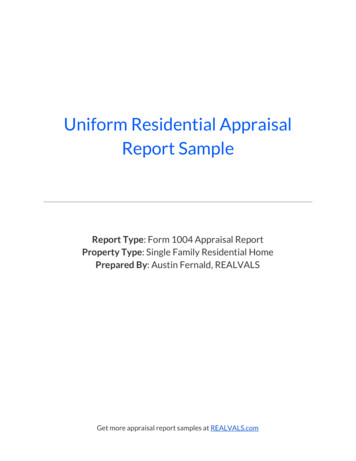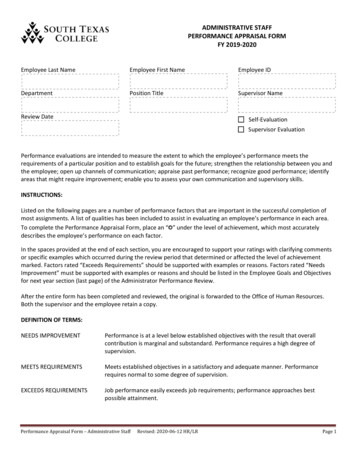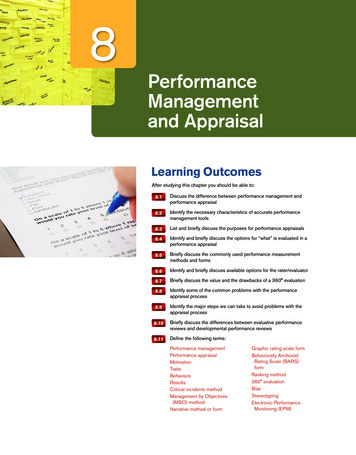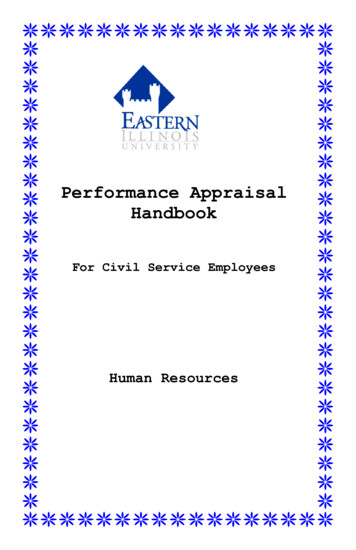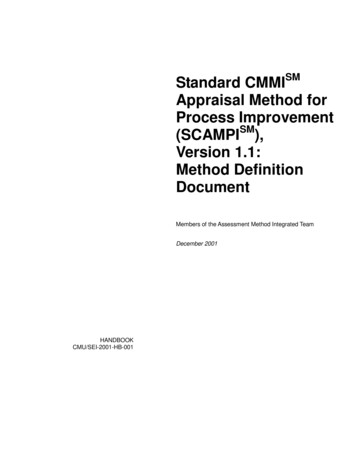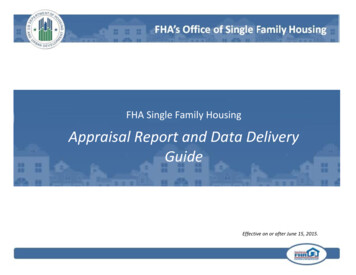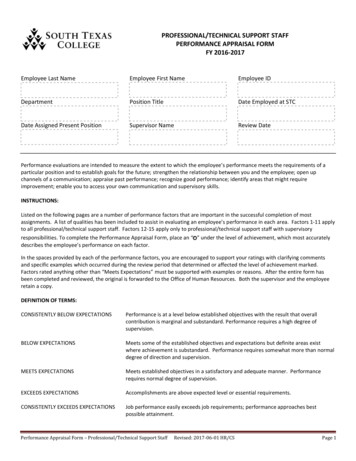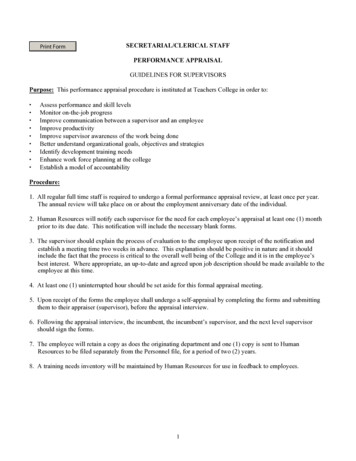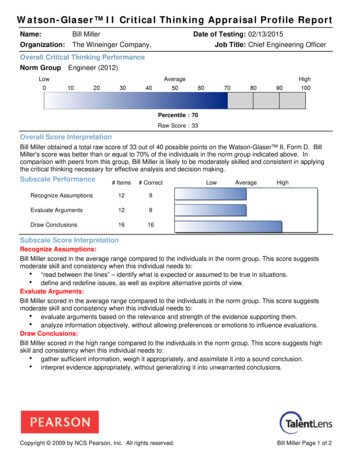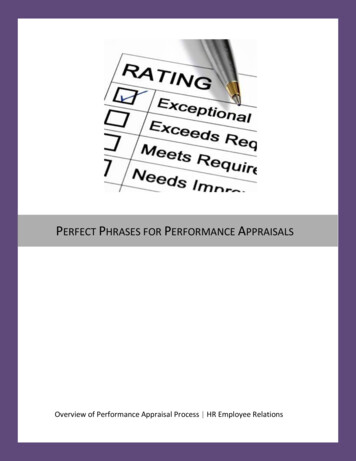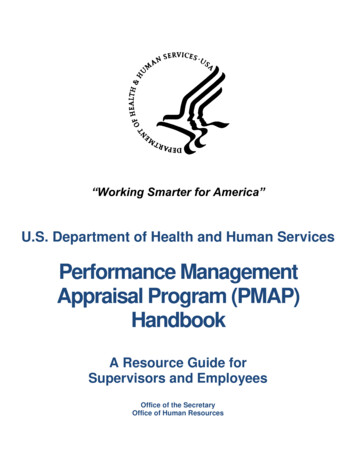
Transcription
“Working Smarter for America”U.S. Department of Health and Human ServicesPerformance ManagementAppraisal Program (PMAP)HandbookA Resource Guide forSupervisors and EmployeesOffice of the SecretaryOffice of Human Resources
HHS PMAP HandbookTABLE OF CONTENTSINTRODUCTION . 4IMPORTANCE OF PERFORMANCE MANAGEMENT . 5PLANNING . 6Developing Performance Plans . 6Employee Performance Plan: HHS Form 704B . 7Administrative Requirements Element . 8Performance Elements. 9Performance Standards. 10Benchmark Standards . 11Employee Participation . 13Documenting Elements and Standards. 14MONITORING PERFORMANCE . 14Feedback During the Performance Cycle . 14Midyear Review . 15DEVELOPING EMPLOYEES . 15Formal Employee Development . 15Informal Employee Development . 16RATING EMPLOYEES. 17Roles of the Rating Official . 17REWARDING PERFORMANCE. 18Performance Award Eligibility . 18ADDRESSING POOR PERFORMANCE. 19Partially Achieved Expected Results Level . 19Achieved Unsatisfactory Results Level. 19Unsatisfactory Performance Vs. Misconduct . 20SUPERVISOR’S CHECKLIST FOR APPRAISALS. 20Meeting with Employees . 20Conducting Midyear Reviews . 21Conducting End-of-Year Reviews . 21EMPLOYEE’S CHECKLIST FOR APPRAISALS. 22Advantages of a Midyear Review to the Employee . 22Employee Preparation for the Midyear Review . 22Employee Preparation for the End-of-Year Review . 23Employee Discussion During the End-of-Year Review . 24DEVELOPING THE INDIVIDUAL DEVELOPMENT PLAN (IDP) . 24Goals of the IDP . 242
HHS PMAP HandbookEmployee’s Responsibilities for an IDP. 26Rating Official’s Responsibilities for an IDP . 26QUESTIONS AND ANSWERS . 27Awards In General . 27Performance-Based Awards . 27Time-Off Awards . 28The Performance Appraisal . 29Labor Relations . 31Quality Step Increase (QSI). 32Performance Plans . 32GUIDE FOR NON-STANDARD SITUATIONS. 35DEFINITIONS . 37APPENDIX I: HANDBOOK ON CASCADING GPRA GOALS . 393
HHS PMAP HandbookINTRODUCTIONManaging employee performance is an integral part of the work that all managers and rating officialsperform throughout the year. It is as important as managing financial resources and programoutcomes because the degree of employee performance has a profound effect on both the financialand programmatic components of any organization.The Performance Management Appraisal Program (PMAP) policy of the Department of Healthand Human Services is designed to document the expectations for both individual andorganizational performance, provide a meaningful process by which employees can berewarded for noteworthy contributions to the organization, and provide direction to improveorganizational success at every level.To accomplish these objectives, managers need to identify organizational goals to beaccomplished, communicate individual and organizational goals to employees that support theoverall strategic mission and the Government Performance and Results Act (GPRA) goals ofthe Department, monitor and evaluate employee performance, and use performance as abasis for appropriate personnel actions including rewarding noteworthy performance andtaking remedial action to improve performance not meeting expectations.The Office of Personnel Management (OPM) defines performance management as thesystematic process of: Planning work and setting expectations. Continually monitoring performance. Developing the capacity to perform. Periodically rating overall performance. Rewarding noteworthy performance.This HHS PMAP Handbook complements the Department’s PMAP policy, dated April 6, 2015,and provides supervisors and employees with a uniform working guide for the day-to-dayadministration of performance management. This handbook is intended to help supervisorsmanage employee performance that is aligned with and in support of organizational goals.This handbook includes step-by-step explanations, and easy-to-follow checklists, for activitiesconducted throughout the performance cycle, and it standardizes working procedures toensure consistent conformance to Departmental requirements. As such, this handbook servesas a valuable training resource especially as a quick overview of performance managementrequirements for supervisors and employees, including new employees.This handbook provides information and guidance and must not be construed to contradictDepartmental PMAP policy or any Collective Bargaining Agreement. Please direct all questions andconcerns to the Performance Management Division, Office of the Secretary, atOSPMAP@HHS.GOV.4
HHS PMAP HandbookIMPORTANCE OF PERFORMANCE MANAGEMENTIn today's workplace, performance improvement and the role of performance management areincreasingly popular topics. Why the intense focus on performance management now? Businesspressures are ever-increasing and organizations are now required to become even more effectiveand efficient, execute better business strategies, and do more with less to remain competitive.The primary reason to ensure performance management processes are functioning properly is totighten the link between strategic business objectives and day-to-day actions. Effective goal setting(including timelines), combined with a method to track progress and identify obstacles, contribute tosuccess and bottom-line results. Regularly tracking progress against performance goals andobjectives also provides the opportunity to recognize and reward employees for performance andexceptional effort, contributing to job satisfaction, and productivity.What is the impact of a poorly structured and implemented performance management process? Ifindividual goals are not aligned with business strategy, then time and resources are wasted. Lowemployee engagement levels may mean that individuals are not performing at their best. Inconsistentevaluation criteria and rewards can lead to mistrust, lower productivity, and higher attrition. If topperformers see no differentiation in performance ratings, no opportunities, and unfair compensationfor under-performers, morale can suffer. Lack of documentation, visibility, and accountability cannegatively affect stakeholders who are demanding more transparency. If accurate performanceinformation is unavailable, or difficult to access, training and development decisions, along withproject assignment decisions, may not be made in the Department’s, or in the individual's, bestinterests. An annual process will not adequately alert managers to problems in a timely manner.Last, but not least, a lack of proper documentation related to performance may result in legal issues.Management "buy-in" is essential to the performance management process. When managementdoes not understand the importance and value of the process, the results can range from consistentlylate or incomplete appraisals to employee-management mistrust, avoidance of performancediscussions, and a lack of honest performance-related discussions. Additionally, managers may feelunprepared to deliver quality feedback and to oversee effective performance discussions.Frequently, when performance management is mentioned, people think of the employee performanceappraisal or review. Performance management, however, involves much more. Properly constructedappraisals should represent a summary of an ongoing and year-long dialogue. An effectiveperformance management process enables managers to evaluate and measure individualperformance and optimize productivity by: Aligning individual employee's day-to-day job responsibilities with strategic businessobjectives. Providing visibility and clarifying accountability related to performance expectations. Documenting individual performance to support compensation and career planning decisions. Establishing focus for skill development and learning opportunities. Creating documentation for Departmental purposes to support decisions and reduce disputes.5
HHS PMAP HandbookMany of the practices that support performance also positively impact job satisfaction, employeeretention, and engagement; as well as trust and loyalty. Performance management practices include: Delivering regular relevant job feedback. Setting and communicating clear performance expectations. Clearly linking performance to compensation. Evaluating performance and delivering incentives in a fair and consistent manner. Providing appropriate learning and development opportunities. Recognizing and rewarding top performers.Employees want to feel successful, to do well at their job, and feel they are making a valuablecontribution. To ensure this happens, employees need a clear understanding of individual goals andhow they fit into the larger organization. When effectively implemented, the best practices ofperformance management result in a wide range of benefits and successes for employees,managers, and the overall organization in the following ways:Organizational Benefits of Effective Performance ceProductivitySupervisors/ManagersTime SavingsReduced ConflictsVisible AccountabilityEfficiencyEmployeesClarification of ExpectationsImproved Self-assessmentImproved PerformanceJob SatisfactionThe Department is taking steps to implement innovative solutions that ensure processes deliver realresults and improve performance. The purpose of this handbook is to provide concrete guidelinesand practical steps that can be used to facilitate improvements to the Department’s performancemanagement processes.PLANNINGIn an effective organization, work is planned in advance. This includes setting performanceexpectations and goals for individuals to channel efforts toward achieving organizational objectives.Involving employees in the planning process is essential to their understanding of the goals of theorganization and expectations, what needs to be done and why for accomplishing those goals.Developing Performance PlansThe regulatory requirements in 5 CFR 430 for defining an employee’s performance expectationsinclude establishing elements and standards in an employee-specific performance plan. Theemployee’s performance plan outlines the specific critical job elements for which the employee will beheld individually accountable during the rating cycle and that must be successfully completed for theorganization to satisfactorily carry out its mission and the standards against which the employee’sperformance will be measured; i.e., how well the employee must perform on each element to beappraised at a specific level. Performance elements and standards should be linked to strategic6
HHS PMAP Handbookorganizational goals, and be results-focused, measurable, understandable, verifiable, equitable,achievable, and provide for meaningful distinctions between levels of performance. In addition, anemployee performance plan should be flexible so that it can be adjusted, as necessary, to reflectchanging program objectives and work requirements. When used effectively, performance plans canbe beneficial working documents that support frequent progress discussions between employee andsupervisor; not merely paperwork that is filed and seen only when ratings of record are required.A technique for establishing a performance plan is to use the “SMART” approach: Specific: Goals and expectations are specific and clearly defined. Measurable: Outcomes are evaluated against quantifiable standards. Attainable: Goals or results/outcomes are achievable and realistic. Relevant: Goals are results-based and advance the operational and strategic missionobjectives of the organization. Timely: Goals are time-bound and results are measured in terms of deadlines, due dates,schedules, or cycles.Employee Performance Plan: HHS Form 704BA critical element is an assignment or responsibility of such importance that unsatisfactoryperformance in that element alone would result in a determination that the employee’s overallperformance is unsatisfactory. As defined by regulation, failure on one or more critical elements canresult in the employee’s reassignment, removal, or change to a lower grade. Consequently, criticalelements must describe work assignments and responsibilities that are significantly influenced by anemployee’s work effort and within the employee’s control.The Department’s Employee Performance Plan template includes two categories of critical elements:(1) Administrative Requirements; and (2) Individual Performance Outcomes; the latter of whichdescribes organization-specific individual management and program outcomes that will contribute tothe success of the OpDivs/StaffDivs and the Department’s strategic mission goals and objectives.These elements describe the work assignments and job responsibilities for which each employee isindividually accountable. Both the Administrative Requirements and each of the elements in theIndividual Performance Outcomes are assessed as critical performance elements.For most employees, this means that critical elements cannot describe a group’s performance.However, a supervisor or manager can and should be held accountable for seeing that resultsmeasured at the group or team level are achieved. Critical elements assessing group performancemay be appropriate to include in the performance plan for a supervisor, manager, or team leader whocan reasonably be expected to command the production and resources necessary to achieve theresults—that is, held individually accountable.Supervisors and managers may use several documents and/or sources to assist them in determiningthe appropriate critical performance elements for their employees. These include but are not limitedto: Goals and objectives outlined in the Department’s Strategic Plan.7
HHS PMAP Handbook Specific performance goals established for a given program area as outlined in theDepartment’s annual performance plan. OpDiv/StaffDiv specific program goals and objectives. Functional area/organizational goals and objectives. Employee Position Description. Laws and/or regulatory requirements. Customer/stakeholder feedback. Employee input.Administrative Requirements ElementDepartment policy requires an Administrative Requirements critical performance element. TheAdministrative Requirements critical element describes successful performance in responsibilities thatare common to most supervisory and non-supervisory employees. For all staff, performance plansshall include the following administrative performance requirements. Supervisors should determinewhich of these areas apply to each position under his/her supervision. Not every position will includeresponsibility for every one of these areas. Provides responsive service to internal/external customers that support customer and programrequirements. Participates with supervisor in establishing individual performance plans and provides selfassessments. Identifies and communicates individual developmental needs consistent with the Department’smission, assists co-workers by mentoring, advising, or guiding them in understanding workassignments as appropriate. Actively identifies, communicates, and implements quality improvements that ensureattainment of workforce goals. When applicable, identifies and addresses weaknesses in grant systems, procurementsystems, and finance offices to ensure recovery of improper payments and to reduce thenumber of improper payments made by the Department. Other aspects described by the rating official.For supervisors, managers, and team leaders, performance plans also shall include the followingcritical administrative performance requirements. Performance of supervisory/managerial duties willbe carried out in accordance with regulatory requirements and other OpDiv/StaffDiv policiesgoverning the duties and responsibilities listed below: Actively engages in the hiring process with the assigned Human Resources specialists fromprocess initiation to completion of on-boarding. This includes ensuring the established hiringprocess timelines are met.8
HHS PMAP Handbook Communicates program and management goals to staff, identifies targeted results/outcomes,and timeframes. Allocates and adjusts resources in response to workload and prioritychanges. Plans, organizes, and assigns unit work. Establishes employee performance plans and completes required reviews and final ratings. Appropriately recognizes and rewards employee performance. Assesses employees' individual developmental needs and provides developmentalopportunities to staff. Ensures employee awareness of, and compliance with, requirements relative to ethics,financial disclosure, avoiding conflicts of interest, standards of ethical conduct, political activity,and procurement integrity. Demonstrates support for EEO/Diversity and employee work-life quality and fosters acooperative work environment where diverse opinions are solicited and respected. Seeks resolution of workplace conflicts at earliest stage. Where applicable, ensures that Departmental, OpDiv/StaffDiv, and program goals andrequirements for correcting grant, procurement, and finance system weaknesses are achievedor exceeded. Other aspects described by the rating official.Performance ElementsThis category identifies the key individual performance outcomes and specific end-results that arecritical to the success of the Department and the OpDivs/StaffDivs. These results-oriented outcomesshould be consistent with strategic planning initiatives, such as the Department’s Strategic Plan andOpDiv/StaffDiv program goals and objectives, and must include one or more outcomes that are linkedto the strategic mission and/or GPRA goals of the Department, OpDiv/StaffDiv, and/or the work unit.Managers should limit the number of outcomes to the three (3) to five (5) most important aspects ofthe employee’s position.Rating officials will determine which appropriate GPRA/mission strategic goals, outcome goals, andoutcome-performance measures are best-suited to define the critical performance elements andevaluation standards for each employee’s performance plan. Performance elements should beclearly labeled on the employee’s performance plan. This cascade approach should ensure thatperformance plans for all employees support the organizational goals of the Department.Each performance element should include at least one accompanying metric that is quantifiable andresults-based, and each metric should contain a specific target-result to be achieved. Metrics shouldaddress significant program outcomes and improvements such as enhanced quality of service orhealthcare, new knowledge and insight from research, increased productivity and quality of service,and/or improvements in customer satisfaction.All objectives must be achievable by the end of the rating period. If quantifiable performance resultswill not be available by the end of the rating period, the plan must specify how success will be9
HHS PMAP Handbookmeasured. Data sources for all metrics must exist, or must be available in time to meet the ratingcompletion deadline. For metrics that are expressed as comparisons to past performance, forexample, to increase production by ten (10) percent, baseline data must be available.Performance StandardsThe Performance Standards define the performance levels, requirements, or expectations that mustbe met for each element to achieve a particular level of performance. The standards must befocused on results and include credible measures at the Achieved Expected Results level, and at thePartially Achieved Expected Results level, if employee performance falls below the AchievedExpected Results level. Types of Standards to consider include the following: Quality: Quality addresses how well the employee or work unit is expected to perform the workand the accuracy, appearance, usefulness, or effectiveness of the final product. Measures caninclude customer satisfaction rates determined through a customer survey/feedback. Quantity: Quantity addresses how much work the employee or work unit is expected toproduce. Measures are expressed as the expected number of completed products or services. Timeliness: Timeliness addresses time-based deadlines within which the employee isexpected to produce the work. Cost-Effectiveness: Cost-effectiveness addresses dollar savings or cost control. Costeffectiveness measures should address specific resource levels or constraints (money,personnel, or time) that can be documented and measured such as maintaining or reducingunit costs, reducing the time it takes to produce or provide a product or service, or reducingwaste.To develop specific measures, the rating official must determine the type or types of standards thatrealistically can be used to assess the outputs, outcomes, or results and progress toward goals for agiven element, and then determine the measures and minimum results/outcomes/outputs that arerequired to achieve the specified performance level of performance. Rating officials should be carefulthat the Achieved Expected Results Standard allows room for errors. Allowing no room for error,referred to as an “absolute” retention standard, is permissible only when an agency can clearlydefend the need for perfection; for example, when a single failure would result in loss of life, injury,breach of national security, or significant monetary loss. In addition, each standard should carefullydefine the outcomes or results required to achieve the specified level of performance; not backwardlydescribe an unacceptable performance level. An example of a backwards standard might be: “makesmore than four (4) errors per document.” This would allow an employee to make one-hundred (100)errors and still be rated at the Achieved Expected Results level.Questions that may help determine whether you are writing an absolute standard include: How many times may the employee fail this requirement and still be performing at theAchieved Expected Results level? Does the Standard use words such as “all”, “never”, and “each”? These words do notautomatically create an absolute standard, but they often alert you to problems.Questions that may help determine whether you are writing a backwards standard include:10
HHS PMAP Handbook Does the standard express the level of work the rating official needs to see or does it describenegative performance? For example, does it state: “requires assistance more than fifty (50)percent of the time?” A better choice is: “works independently at least fifty (50) percent of thetime.” If the employee did nothing, would he/she meet the standard, as written? For example, does itstate: “completes fewer than four (4) products per year.” A better choice is: “no more thanthree (3) products are incomplete at the established deadline.”The Benchmark Standards listed below are listed on the HHS Form 704B and may be used todescribe required performance levels for all critical elements. Using the described benchmarkstandard is not mandatory. However, if the benchmark standards below are not used, standardsdeveloped by the rating official should require levels of performance that are essentially equivalent tothat described by the benchmark standard at each level. When benchmark standards are used,additional specific, measurable criteria must be developed at the Achieved Expected Results level foreach critical element except the Administrative Requirements critical element. While each and everycriterion described in the benchmark standards will not have to be met by the employee in absoluteterms to assign a particular rating level, the rating official must ensure the employee understands theoverall level of performance he/she is expected to meet to be assigned a given rating level. TheAdministrative Requirements critical element may be applied without modification and the benchmarkstandards do not need any augmentation. While 5 CFR 430 requires specific, measurable criteria tobe identified at the Achieved Expected Results level, rating officials are strongly encouraged todevelop measurable criteria at all levels so employees fully and clearly understand their performanceexpectations.Benchmark StandardsLevel 5: Achieved Outstanding Results (AO): Consistently superior, significantly exceeds Level 4(AM) performance requirements. Despite major challenges such as changing priorities, insufficientresources, unanticipated resource shortages, or externally driven parameters, employee leadership isa model of excellence. Contributions impact well beyond the employee’s level of responsibility. Theydemonstrate exceptional initiative in achieving results critical to Departmental success and strategicgoals. Products and skills create significant changes in their area of responsibility and authority.Indicators of performance at this level include outcomes that consistently exceed the AM levelstandards for critical elements described in the annual performance plan. Examples include: Innovations, improvements, and contributions to management, administrative, technical, orother fu
The Performance Management Appraisal Program (PMAP) policy of the Department of Health and Human Services is designed to document the expectations for both individual and organizational performance, provide a meaningful process by which employees can be rewarded for noteworthy contributi
